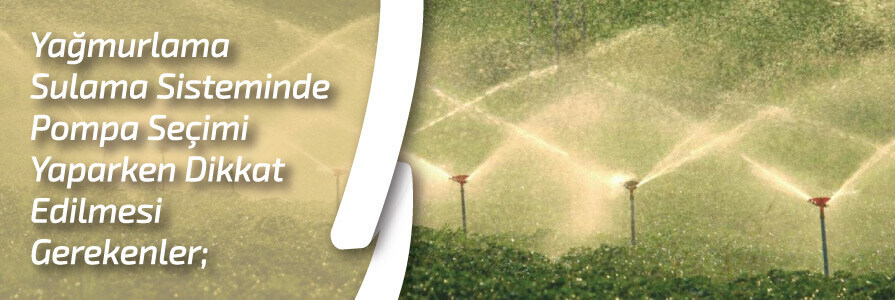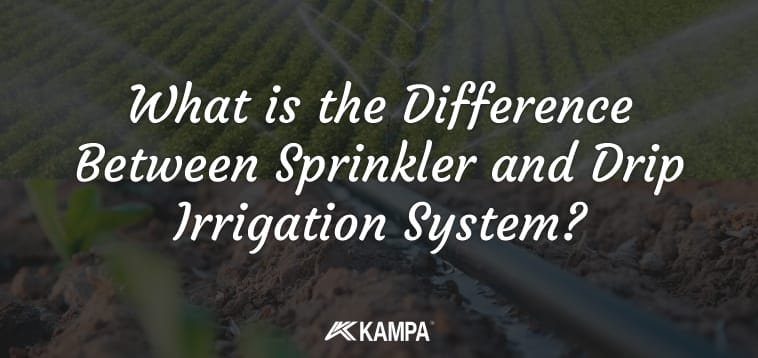What is the Difference Between Sprinkler and Drip Irrigation System?
Hello friends, first of all, let’s summarize the difference between sprinkler and drip irrigation system in general terms if we examine both irrigation systems separately;
Sprinkler Irrigation System:
The sprinkler irrigation system gets its name from the fact that water is sprayed onto the plants in a way that resembles the way the rain water the plants. In this system, water is sprayed through nozzles or sprinklers under a certain pressure to effectively irrigate large areas. Sprinkler irrigation system is widely used in agricultural fields, farms and large gardens. Here are some features of a sprinkler irrigation system:
- The sprayed water falls in a pattern similar to raindrops, making it ideal for effectively irrigating large areas.
- As the system sprays water at high pressure, it can cause water to be carried through the air and dispersed over a certain area. In this case, water loss may occur in windy weather.
- It works more efficiently on flat and smooth terrain.
- It is used in agricultural production, especially in crops such as cereals, corn and potatoes.
- It can be easily integrated with automatic irrigation systems.
- Easy to maintain and install.

Drip Irrigation System:
A drip irrigation system is a method of irrigation in which water is delivered to the root zone of plants in a direct and controlled drip. This system uses a network of regular low-flow drops that allow water to reach the plants through pipes or hoses. Here are some features of a drip irrigation system:
- Since water is delivered directly to the plant root zone drop by drop, water loss is minimal and water efficiency is high.
- Since the soil surface does not get wet, weed growth and water evaporation are reduced.
- It can also be used effectively on high slopes and irregular terrain.
- The amount of water can be controlled according to the needs of the plants, so the water uptake rate of the plants can be better adjusted.
- The drip irrigation system is especially ideal for vegetable gardens, vineyards, fruit trees and ornamental plants.
- It can also be used with automatic irrigation systems, so that the irrigation program can be set regularly.
Both systems are used to meet plant irrigation needs, but they differ in their intended use and water efficiency. Drip irrigation is generally the preferred method for saving water and for better growth and productivity of plants.
WHAT IS THE DIFFERENCE BETWEEN SPRINKLER AND DRIP IRRIGATION SYSTEM?
If we explain the differences and advantages between sprinkler irrigation system and drip irrigation system below;
Sprinkler Irrigation System:
The difference between sprinkler and drip irrigation system:
- Irrigation Method: A sprinkler irrigation system sprays water onto plants like raindrops. The water is spread over a large area under a certain pressure by nozzles or sprinklers.
- Area Capacity: Suitable for efficiently irrigating large areas and used in agricultural fields, farms and large gardens.
- Water Dispersion: In windy weather, water can be lost due to water dispersion and evaporation.
- Controllability: It is difficult to control and direct the flow of water, so water yields may be low in some areas.
Advantages:
- Fast Irrigation: Suitable for irrigating large areas quickly and saves time in large agricultural areas.
- Automatic Irrigation: It can be easily integrated with automatic irrigation systems and the irrigation schedule can be set regularly.
- Easy Installation: Easy to install and generally works more efficiently on flat and level terrain.
- Cost-effective: It is more cost-effective than some other irrigation methods.
Drip Irrigation System:
The difference between sprinkler and drip irrigation system:
- Irrigation Method: The drip irrigation system is an irrigation method in which water is dripped directly into the plant root zone.
- Area Capacity: Ideal for small to medium-sized areas, especially in gardens, vegetable plots, vineyards and fruit trees.
- Water Distribution: Since water is supplied directly to the plant root zone, water loss is minimal and water efficiency is high.
- Controllability: The water flow can be easily controlled and the amount of water can be adjusted according to the needs of the plants.
Advantages:
- Water Saving: The drip irrigation system minimizes water loss and uses water efficiently, which saves water.
- Plant Health: Providing water directly to the root zone of plants improves plant health and productivity.
- High Productivity: The water intake of plants can be controlled so that their water needs are better met and productivity increases.
- Reduced Weed Problem: Since the soil surface does not get wet, weed formation decreases.
- Suitability for Sloping and Irregular Terrain: It can also be used effectively on highly sloping or irregular terrain.
In summary, sprinkler irrigation system is suitable for irrigating large areas quickly, while drip irrigation system saves water, improves plant health and is especially preferred in small and medium-sized areas. The irrigation method to be chosen may vary depending on factors such as the size of the irrigated area, plant type, climatic conditions and water resources.
Which type of pumps and materials should be used in sprinkler and drip irrigation systems?
Pump selection and material selection are very important for the irrigation system and should be determined according to various factors. Let us specify the pump types models suitable for sprinkler irrigation system and drip irrigation system for you;
Sprinkler Irrigation System:
Pump: A sprinkler irrigation system requires a high-pressure pump to spray water under a certain pressure. This pump must be able to generate enough pressure to distribute the water evenly over a large area through nozzles or sprinklers.
Centrifugal pumps, submersible pumps or cascade pumps are often used to provide high flow and pressure. These types of pumps are common options used in sprinkler irrigation systems.
Materials: The materials used for a sprinkler irrigation system include
- Pipes or Hoses: Plastic or PVC pipes, galvanized steel pipes or flexible hoses can be used to transport water.
- Nozzles or Sprinklers: They are used to spray water and can have different water flow angles and ranges.
- Fittings: Used for joining pipes and assembling the system.
- Valves and Controllers: Used to control water flow and can be integrated with timers or sensors for automatic irrigation systems.
Drip Irrigation System:
Pump: A drip irrigation system requires a pump that operates at low pressure. In this system, high pressure and flow are not required as the water is delivered drop by drop. Low pressure and flow centrifugal pumps and submersible pumps are suitable options for drip irrigation systems.

Materials: The materials used for a drip irrigation system include
- Drip Pipes or Hoses: Special drip pipes or hoses are used that can control the flow of water and ensure that water is delivered drop by drop to the root zone of the plants with regular drops.
- Drilling Tools: Drilling tools are used to drill holes in drip pipes and to attach drip drops.
- Fittings: Used for joining pipes and assembling the system.
- Filters: Used to filter dissolved particles and impurities from the water, thus preventing clogging of drip pipes.
Both irrigation systems require different types of pumps and materials according to their characteristics. In pump selection, factors such as the size of the irrigation area, plant type, water source and budget should be considered. In addition, the difference between sprinkler and drip irrigation systems, local conditions and expert opinions should also be evaluated.
🚩For product selection and offers;
📳 05495413607
📧 dijital@kampacompany.com
✅ ADDS VALUE TO KAMPA

